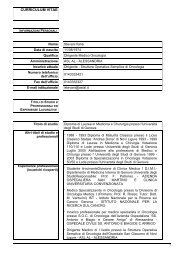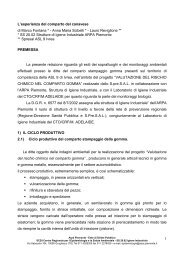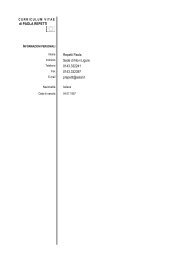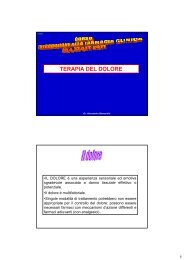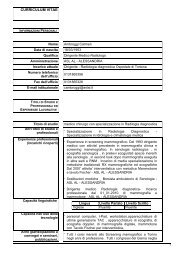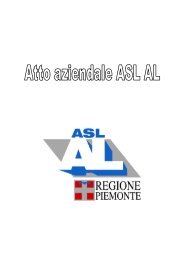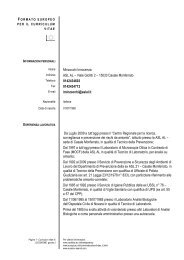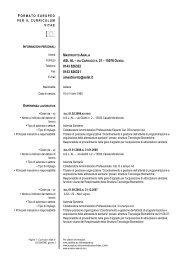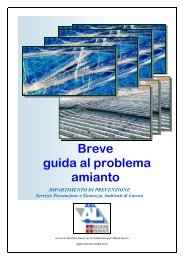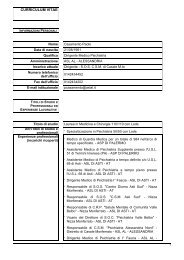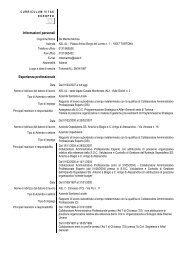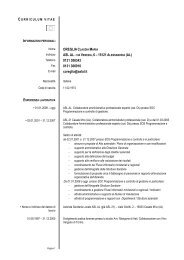Il trasporto degli animali al macello: problemi di benessere ... - ASL AL
Il trasporto degli animali al macello: problemi di benessere ... - ASL AL
Il trasporto degli animali al macello: problemi di benessere ... - ASL AL
Create successful ePaper yourself
Turn your PDF publications into a flip-book with our unique Google optimized e-Paper software.
<strong>Il</strong> <strong>trasporto</strong> <strong>degli</strong> <strong>anim<strong>al</strong>i</strong> <strong>al</strong><br />
<strong>macello</strong>: <strong>problemi</strong> <strong>di</strong><br />
<strong>benessere</strong> anim<strong>al</strong>e e qu<strong>al</strong>ità qu<strong>al</strong>it<br />
delle carni<br />
dott. giancarlo nervi<br />
veterinario <strong>di</strong>rigente <strong>ASL</strong><br />
Alessandria
Un argomento molto <strong>di</strong>battuto:<br />
Nell’anim<strong>al</strong>e Nell anim<strong>al</strong>e non dobbiamo solo vedere un<br />
essere utile e <strong>di</strong> v<strong>al</strong>ore ma speci<strong>al</strong>mente un<br />
essere sensibile il cui <strong>benessere</strong> ci deve<br />
stare a cuore come quello del nostro<br />
prossimo
Anni trenta del secolo scorso:<br />
Le prime leggi inerenti il <strong>benessere</strong> <strong>degli</strong><br />
<strong>anim<strong>al</strong>i</strong> <strong>al</strong> <strong>macello</strong> sono state promulgate d<strong>al</strong><br />
II Reich!!! Reich!!!
Premessa<br />
Trasporto <strong>di</strong><br />
<strong>anim<strong>al</strong>i</strong> che non<br />
sono in grado <strong>di</strong><br />
spostarsi<br />
autonomamente<br />
senza<br />
sofferenza o <strong>di</strong><br />
deambulare<br />
senza aiuto
PREMESSA<br />
gli <strong>anim<strong>al</strong>i</strong> feriti o m<strong>al</strong>ati devono essere<br />
macellati o abbattuti sul posto; il veterinario<br />
uffici<strong>al</strong>e può tuttavia, autorizzare il loro<br />
<strong>trasporto</strong> per la macellazione o l’abbattimento<br />
purché ciò non comporti ulteriori sofferenze<br />
<strong>al</strong>l’articolo 12 del D. Lvo 333/98, che<br />
recepisce la <strong>di</strong>rettiva 93/119/CE
PREMESSA<br />
“gli <strong>anim<strong>al</strong>i</strong> che presentino lesioni o <strong>problemi</strong><br />
fisiologici ovvero patologie non vanno<br />
considerati idonei <strong>al</strong> <strong>trasporto</strong>, in particolare<br />
se:<br />
(omissis) non sono in grado <strong>di</strong> spostarsi<br />
autonomamente senza sofferenza o <strong>di</strong><br />
deambulare senza aiuto”.<br />
All. I, Capo 1, punto 2, Reg (CE) 1/2005<br />
(protezione <strong>degli</strong> <strong>anim<strong>al</strong>i</strong> durante il <strong>trasporto</strong>)
PREMESSA<br />
“gli <strong>anim<strong>al</strong>i</strong> che presentino lesioni o <strong>problemi</strong><br />
fisiologici ovvero patologie non vanno<br />
considerati idonei <strong>al</strong> <strong>trasporto</strong>, in particolare<br />
se:<br />
(omissis) presentano una ferita aperta <strong>di</strong><br />
natura grave o un prolasso”.<br />
All. I, Capo 1, punto 2, Reg (CE) 1/2005<br />
(protezione <strong>degli</strong> <strong>anim<strong>al</strong>i</strong> durante il <strong>trasporto</strong>)
PREMESSA<br />
“gli <strong>anim<strong>al</strong>i</strong> che presentino lesioni o <strong>problemi</strong><br />
fisiologici ovvero patologie non vanno<br />
considerati idonei <strong>al</strong> <strong>trasporto</strong>, in particolare<br />
se:<br />
(omissis) sono femmine gravide che hanno<br />
superato il 90% del periodo <strong>di</strong> gestazione<br />
previsto ovvero femmine che hanno partorito<br />
durante la settimana precedente”.<br />
All. I, Capo 1, punto 2, Reg (CE) 1/2005<br />
(protezione <strong>degli</strong> <strong>anim<strong>al</strong>i</strong> durante il <strong>trasporto</strong>)
PREMESSA<br />
“gli <strong>anim<strong>al</strong>i</strong> che presentino lesioni o <strong>problemi</strong><br />
fisiologici ovvero patologie non vanno<br />
considerati idonei <strong>al</strong> <strong>trasporto</strong>, in particolare<br />
se:<br />
(omissis) sono mammiferi neonati il cui<br />
ombelico non è ancora completamente<br />
cicatrizzato”.<br />
All. I, Capo 1, punto 2, Reg (CE) 1/2005<br />
(protezione <strong>degli</strong> <strong>anim<strong>al</strong>i</strong> durante il <strong>trasporto</strong>)
PREMESSA<br />
gli <strong>anim<strong>al</strong>i</strong> m<strong>al</strong>ati o che presentano lesioni<br />
possono essere ritenuti idonei <strong>al</strong> <strong>trasporto</strong> se:<br />
presentano lesioni o m<strong>al</strong>attie lievi e il loro<br />
<strong>trasporto</strong> non causerebbe sofferenze<br />
ad<strong>di</strong>zion<strong>al</strong>i;<br />
nei casi dubbi si chiede un parere veterinario;<br />
All. I, Capo 1, punto 3, lettere a) Reg (CE) 1/2005<br />
(protezione <strong>degli</strong> <strong>anim<strong>al</strong>i</strong> durante il <strong>trasporto</strong>)
PREMESSA<br />
TRATTAMENTO<br />
DEGLI ANIM<strong>AL</strong>I<br />
1.8 È proibito:<br />
a) percuotere o dare c<strong>al</strong>ci agli <strong>anim<strong>al</strong>i</strong>;<br />
b) comprimerne parti sensibili del corpo in modo t<strong>al</strong>e da<br />
causare loro dolore o sofferenze inutili;<br />
c) sospendere gli <strong>anim<strong>al</strong>i</strong> con mezzi meccanici;<br />
d) sollevare o trascinare gli <strong>anim<strong>al</strong>i</strong> per il capo, le orecchie, le<br />
corna, le zampe, la coda o il vello o trattarli in modo t<strong>al</strong>e da<br />
causare loro dolore o sofferenze inutili;<br />
e) usare pungoli o <strong>al</strong>tri strumenti con estremità aguzze;<br />
f) ostruire volutamente il passaggio <strong>di</strong> un anim<strong>al</strong>e spinto o<br />
condotto per qu<strong>al</strong>siasi luogo in cui gli <strong>anim<strong>al</strong>i</strong> debbano essere<br />
trattati.
PREMESSA<br />
TRATTAMENTO<br />
DEGLI ANIM<strong>AL</strong>I<br />
1.9 Dev'essere evitato, nella misura del possibile, l'uso <strong>di</strong><br />
strumenti che trasmettono scariche elettriche. In ogni caso<br />
t<strong>al</strong>i strumenti sono usati solo su bovini o suini adulti che<br />
rifiutano <strong>di</strong> spostarsi, e soltanto se hanno davanti a sé<br />
spazio per muoversi. Le scariche non devono durare più <strong>di</strong> un<br />
secondo, devono essere trasmesse ad interv<strong>al</strong>li adeguati e<br />
applicate soltanto ai muscoli dei quarti posteriori. Le scariche<br />
non devono essere applicate ripetutamente<br />
se l'anim<strong>al</strong>e non reagisce.<br />
1.10 Quando necessario i mercati o i centri <strong>di</strong> raccolta<br />
devono fornire <strong>di</strong>spositivi appropriati per legare gli <strong>anim<strong>al</strong>i</strong>.<br />
Gli <strong>anim<strong>al</strong>i</strong> non abituati ad essere legati devono restare<br />
slegati. Gli <strong>anim<strong>al</strong>i</strong> debbono avere accesso <strong>al</strong>l'acqua.
PREMESSA<br />
TRATTAMENTO<br />
DEGLI ANIM<strong>AL</strong>I<br />
1.11 Gli <strong>anim<strong>al</strong>i</strong> non devono essere legati per le corna, i<br />
p<strong>al</strong>chi, gli anelli nas<strong>al</strong>i né per le zampe legate assieme. Ai<br />
vitelli non deve essere messa museruola. Gli equi<strong>di</strong> domestici<br />
<strong>di</strong> oltre otto mesi devono recare cavezze durante il <strong>trasporto</strong>,<br />
fatta eccezione per i cav<strong>al</strong>li non domati.<br />
Se gli <strong>anim<strong>al</strong>i</strong> devono essere legati, le corde, le pastoie o gli<br />
<strong>al</strong>tri mezzi usati devono essere:<br />
a) sufficientemente forti per non spezzarsi durante con<strong>di</strong>zioni<br />
<strong>di</strong> <strong>trasporto</strong> norm<strong>al</strong>i;<br />
b) t<strong>al</strong>i da consentire agli <strong>anim<strong>al</strong>i</strong>, se necessario, <strong>di</strong> coricarsi e<br />
<strong>di</strong> mangiare e bere;<br />
c) concepiti in modo t<strong>al</strong>e da eliminare il pericolo <strong>di</strong><br />
strangolamento o <strong>di</strong> lesione ma anche da permettere <strong>di</strong><br />
liberare rapidamente gli <strong>anim<strong>al</strong>i</strong>.
PREMESSA<br />
OSA (<strong>al</strong>levatori) devono rispettare le pertinenti<br />
<strong>di</strong>sposizioni legislative comunitarie e nazion<strong>al</strong>i<br />
relative ai rischi nella produzione primaria e<br />
nelle operazioni associate, comprese le<br />
misure relative <strong>al</strong>la s<strong>al</strong>ute e <strong>al</strong> <strong>benessere</strong><br />
<strong>degli</strong> <strong>anim<strong>al</strong>i</strong><br />
All. II, par. II lettera 3b) Reg (CE) 852/2004<br />
(igiene dei prodotti <strong>al</strong>imentari)
PREMESSA<br />
OSA (trasportatori) che trasportano<br />
<strong>anim<strong>al</strong>i</strong> vivi <strong>al</strong> <strong>macello</strong> devono accertarsi<br />
che durante la raccolta e il <strong>trasporto</strong>, gli<br />
<strong>anim<strong>al</strong>i</strong> vengano manipolati con cura<br />
evitando inutili sofferenze<br />
All. III, Sez. I. cap. I Reg (CE) 853/2004 (norme<br />
specifiche in materia <strong>di</strong> igiene per gli <strong>al</strong>imenti O.A.)
PREMESSA<br />
OSA che intende avviare <strong>al</strong> <strong>macello</strong> un<br />
capo è tenuto a movimentarlo <strong>al</strong>l’interno<br />
dell’azienda e a caricarlo evitando<br />
sofferenze <strong>al</strong>l’anim<strong>al</strong>e;<br />
nel caso non ritenga l’anim<strong>al</strong>e idoneo <strong>al</strong><br />
<strong>trasporto</strong> richiede l’intervento del<br />
veterinario uffici<strong>al</strong>e
POSSIBILITA’ POSSIBILITA<br />
POSSIBILITA’ DI MACELLAZIONE<br />
Macellazione d’urgenza in <strong>al</strong>levamento<br />
Macellazione d’emergenza <strong>al</strong> <strong>macello</strong>
MACELLAZIONE D’URGENZA<br />
URGENZA<br />
Macellazione d’urgenza in <strong>al</strong>levamento<br />
MSU MU<br />
Macellazione speci<strong>al</strong>e d'urgenza: macellazione or<strong>di</strong>nata da un veterinario<br />
uffici<strong>al</strong>e in seguito, ad un incidente o <strong>al</strong>lorché l'anim<strong>al</strong>e soffra <strong>di</strong> gravi <strong>di</strong>sturbi<br />
fisiologici e funzion<strong>al</strong>i; la macellazione speci<strong>al</strong>e d'urgenza è effettuata in luogo<br />
<strong>di</strong>verso d<strong>al</strong> <strong>macello</strong> <strong>al</strong>lorché il veterinario uffici<strong>al</strong>e ritenga che il <strong>trasporto</strong><br />
dell'anim<strong>al</strong>e sia impossibile o imporrebbe <strong>al</strong>l'anim<strong>al</strong>e inutili sofferenze<br />
Le carni provenienti da <strong>anim<strong>al</strong>i</strong> macellati d'urgenza possono essere ammesse<br />
<strong>al</strong> consumo umano solo nel territorio dell'unità sanitaria loc<strong>al</strong>e ove è avvenuta<br />
la macellazione<br />
l'anim<strong>al</strong>e abbattuto e <strong>di</strong>ssanguato sia trasportato in un <strong>macello</strong> in con<strong>di</strong>zioni<br />
igieniche sod<strong>di</strong>sfacenti e il più rapidamente possibile; qu<strong>al</strong>ora l'anim<strong>al</strong>e<br />
macellato non possa essere trasportato entro un'ora in t<strong>al</strong>e <strong>macello</strong> esso deve<br />
essere trasportato in un contenitore o con <strong>al</strong>tro mezzo <strong>di</strong> <strong>trasporto</strong> in cui la<br />
temperatura sia compresa tra 0° e 4°C; l'eviscerazione, qu<strong>al</strong>ora non sia stata<br />
praticata <strong>al</strong> momento della macellazione, deve essere effettuata <strong>al</strong> più tar<strong>di</strong> tre<br />
ore dopo quest'ultima; qu<strong>al</strong>ora l'eviscerazione sia praticata sul posto i visceri<br />
devono accompagnare la carcassa fino <strong>al</strong> <strong>macello</strong>, fermo restando che i<br />
polmoni, il cuore, il fegato, i reni, la milza e i linfono<strong>di</strong> me<strong>di</strong>astinici siano lasciati<br />
aderenti <strong>al</strong>la carcassa me<strong>di</strong>ante le loro connessioni anatomiche;<br />
siano contrassegnate, in caso <strong>di</strong> ispezione favorevole, con il bollo sanitario<br />
specifico<br />
macellazione d'urgenza: or<strong>di</strong>nata da un veterinario uffici<strong>al</strong>e per un anim<strong>al</strong>e<br />
che, per il resto sano deve aver subito un incidente che ne ha impe<strong>di</strong>to il<br />
<strong>trasporto</strong> <strong>al</strong> <strong>macello</strong> per considerazioni relative <strong>al</strong> suo <strong>benessere</strong><br />
Le carni provenienti da <strong>anim<strong>al</strong>i</strong> macellati d'urgenza possono essere immesse<br />
nel mercato soltanto nello Stato membro in cui si effettua la macellazione ed in<br />
conformità della legislazione nazion<strong>al</strong>e (province e province contermini,<br />
destinate esclusivamente <strong>al</strong> consumatore fin<strong>al</strong>e o a un dettagliante perla<br />
ven<strong>di</strong>ta <strong>al</strong> consumatore fin<strong>al</strong>e).<br />
l'anim<strong>al</strong>e macellato e <strong>di</strong>ssanguato deve essere trasportato <strong>al</strong> <strong>macello</strong> in<br />
con<strong>di</strong>zioni igieniche sod<strong>di</strong>sfacenti e senza indebito ritardo. L'asportazione dello<br />
stomaco e <strong>degli</strong> intestini, ma nessuna <strong>al</strong>tra tolettatura può essere praticata sul<br />
posto sotto la supervisione del veterinario. I visceri asportati devono<br />
accompagnare l'anim<strong>al</strong>e abbattuto <strong>al</strong> <strong>macello</strong> ed essere identificati come<br />
appartenenti <strong>al</strong>l'anim<strong>al</strong>e stesso. Se trascorrono più <strong>di</strong> due ore tra l'operazione<br />
<strong>di</strong> macellazione e l'arrivo <strong>al</strong> <strong>macello</strong> l'anim<strong>al</strong>e deve essere refrigerato. Se le<br />
con<strong>di</strong>zioni climatiche lo consentono, la refrigerazione attiva non è necessaria<br />
siano contrassegnate, in caso <strong>di</strong> ispezione favorevole, con il bollo sanitario<br />
specifico
MACELLAZIONE D’EMERGENZA<br />
EMERGENZA<br />
Al <strong>macello</strong>, dopo la visita clinica ante mortem,<br />
l’anim<strong>al</strong>e è stor<strong>di</strong>to sul mezzo <strong>di</strong> <strong>trasporto</strong> e<br />
imme<strong>di</strong>atamente introdotto nel loc<strong>al</strong>e <strong>di</strong><br />
macellazione per le successive fasi <strong>di</strong> lavorazione.<br />
Nel caso in cui sia necessario <strong>di</strong>fferire la<br />
macellazione per evitare possibili contaminazioni<br />
delle carni in lavorazione (macellazione<br />
d’emergenza separata) è in<strong>di</strong>spensabile adottare<br />
tutte le misure idonee per evitare ulteriori<br />
sofferenze dell’anim<strong>al</strong>e e comunque procedere<br />
<strong>al</strong>la macellazione nel più breve tempo possibile.
La frollatura<br />
L’et età dell’anim<strong>al</strong>e dell anim<strong>al</strong>e influenza la maturazione:<br />
anim<strong>al</strong>e giovane tempi più pi brevi
Come avviene:<br />
La risoluzione dello stato <strong>di</strong> rigor mortis<br />
avviene grazie <strong>al</strong>la proteolisi enzimatica.<br />
<strong>Il</strong> rigor mortis compare dopo <strong>al</strong>cune ore<br />
d<strong>al</strong>la morte<br />
La gicogenolisi porta ad un abbassamento<br />
del ph delle carni (da 7,3-7,5 7,3 7,5 a 5,3-5,5) 5,3 5,5)
Lo stress<br />
In con<strong>di</strong>zioni <strong>di</strong> stress e conseguenti<br />
scariche <strong>di</strong> adren<strong>al</strong>ina,vengono mobilizzate<br />
ed utilizzate le riserve <strong>di</strong> glicogeno<br />
muscolare.<br />
Senza glicogeno muscolare non si arriva ai<br />
livelli <strong>di</strong> ph acido prima descritti
RILIEVI ISPETTIVI<br />
Carni Dark, Firm, Dry (DFD)<br />
Interessa in particolare i bovini.<br />
Le carni si presentano <strong>di</strong> colore rosso-brunastro, consistenti e<br />
<strong>di</strong> aspetto asciutto.<br />
T<strong>al</strong>e <strong>al</strong>terazione è dovuta a un’insufficiente aci<strong>di</strong>ficazione delle<br />
carni per esaurimento delle riserve <strong>di</strong> glicogeno. <strong>Il</strong> glicogeno<br />
può <strong>di</strong>minuire drasticamente a seguito <strong>di</strong> patologie debilitanti o<br />
semplicemente per attività fisica o stress prima della<br />
macellazione (<strong>trasporto</strong>, carico e scarico, soste prolungate,<br />
freddo).<br />
In con<strong>di</strong>zioni <strong>di</strong> insufficiente aci<strong>di</strong>ficazione, numerose specie<br />
batteriche possono moltiplicarsi abnormemente e determinare<br />
<strong>al</strong>terazioni delle carni.
Emorragie da stress
Mort<strong>al</strong>ità Mort<strong>al</strong>it <strong>al</strong> <strong>macello</strong><br />
RILIEVI ISPETTIVI<br />
Eziologia delle patologie legate <strong>al</strong> <strong>trasporto</strong><br />
<strong>Il</strong> <strong>trasporto</strong> rappresenta un fattore critico per la s<strong>al</strong>ute <strong>degli</strong> <strong>anim<strong>al</strong>i</strong> d<strong>al</strong><br />
momento che è in grado <strong>di</strong> scatenare m<strong>al</strong>attie latenti soggetti<br />
pre<strong>di</strong>sposti o <strong>di</strong> determinare <strong>di</strong>rettamente patologie specifiche.<br />
Con<strong>di</strong>zioni attraverso le qu<strong>al</strong>i il <strong>trasporto</strong> può indurre patologie:<br />
1. Maggior richiesta funzion<strong>al</strong>e<br />
2. Stress<br />
3. Temperatura (c<strong>al</strong>ore, freddo)<br />
4. Traumi<br />
5. Carenze <strong>al</strong>imentari (cibo, acqua)<br />
6. Infezioni<br />
Fattori che possono agire singolarmente o in modo combinato
MORT<strong>AL</strong>ITÀ MORT<strong>AL</strong>IT IN GABBIA<br />
Eccessiva umi<strong>di</strong>tà in inverno<br />
Con<strong>di</strong>zioni climatiche avverse ( pioggia –<br />
freddo)<br />
Lunghe <strong>di</strong>stanze<br />
Scarsa protezione <strong>degli</strong> automezzi<br />
Narcosi da freddo<br />
ASSIDERAMENTO
MORT<strong>AL</strong>ITÀ MORT<strong>AL</strong>IT IN GABBIA<br />
Errate manu<strong>al</strong>ità manu<strong>al</strong>it <strong>di</strong> ingabbiamento<br />
Alte temperature<br />
Digiuno pre macellazione non adeguato<br />
Alta umi<strong>di</strong>tà umi<strong>di</strong>t relativa<br />
Eccessiva densità densit<br />
SOFFOCAMENTO
RILIEVI ISPETTIVI<br />
Maggior richiesta funzion<strong>al</strong>e<br />
Le operazioni <strong>di</strong> carico e scarico ed il <strong>trasporto</strong> stesso obbligano gli<br />
<strong>anim<strong>al</strong>i</strong> ad una attività fisica a cui non sono abituati nelle con<strong>di</strong>zioni <strong>di</strong><br />
<strong>al</strong>levamento intensivo.<br />
Questo fatto è particolarmente importante considerando che il<br />
<strong>trasporto</strong> <strong>al</strong> <strong>macello</strong> è effettuato quando gli <strong>anim<strong>al</strong>i</strong> hanno raggiunto<br />
una massa corporea ragguardevole non adeguatamente<br />
compensata.<br />
I tipi <strong>di</strong> attività che vengono particolarmente<br />
sollecitati sono:<br />
1. Attività musco-scheletrica<br />
2. Attività car<strong>di</strong>aca<br />
3. Attività respiratoria
RILIEVI ISPETTIVI<br />
Colpo <strong>di</strong> c<strong>al</strong>ore<br />
È una tipica patologia dei mesi estivi dovuta a ostacolata<br />
termo<strong>di</strong>spersione. È favorita d<strong>al</strong>l’ammassamento <strong>degli</strong> <strong>anim<strong>al</strong>i</strong>.<br />
Effettuare il <strong>trasporto</strong> durante le ore più fresche del giorno e<br />
<strong>di</strong>minuire la concentrazione <strong>degli</strong> <strong>anim<strong>al</strong>i</strong> rappresentano<br />
semplici accorgimenti pratici che devono essere adottati nei<br />
mesi estivi per evitare l’insorgenza <strong>di</strong> questa patologia.<br />
Sintomi - Inizi<strong>al</strong>mente stato eccitativo, poi apatia, cianosi,<br />
<strong>di</strong>spnea, ipertermia, coma.<br />
Lesioni - Stasi ematica gener<strong>al</strong>izzata, degenerazione torbida<br />
dei parenchimi.
RILIEVI ISPETTIVI
RILIEVI ISPETTIVI
RILIEVI ISPETTIVI
ERITEMA DA TRASPORTO<br />
RILIEVI ISPETTIVI<br />
(transit transit erythema o lime burning) burning<br />
forte affaticamento fisico, stress
SINDROME DA STRESS DEL<br />
RILIEVI ISPETTIVI<br />
SUINO: PSS (porcine stress<br />
syndrome) syndrome<br />
Insufficienza car<strong>di</strong>ovascolare acuta<br />
causa la morte improvvisa del suino<br />
da <strong>macello</strong> soprattutto <strong>al</strong> <strong>trasporto</strong>.<br />
I sintomi: tremori, <strong>di</strong>spnea, comparsa<br />
sulla pelle <strong>di</strong> zone irregolari rosse e<br />
p<strong>al</strong>lide, anim<strong>al</strong>e immobile e morte<br />
dopo pochi minuti. Rigi<strong>di</strong>tà Rigi<strong>di</strong>t cadaverica<br />
quasi imme<strong>di</strong>ata.
Rigi<strong>di</strong>tà Rigi<strong>di</strong>t cadaverica precoce
Quadro anatomopatologico:<br />
Lesioni muscolari car<strong>di</strong>ache e scheletriche<br />
Idropericar<strong>di</strong>o<br />
Edema polmonare<br />
Cuore solitamente <strong>di</strong>latato<br />
Iperemia della mucosa gastica<br />
PSE (p<strong>al</strong>e, soft, exudative) exudative<br />
Necrosi del muscolo del dorso (back<br />
muscle necrosis, necrosis,<br />
m. longissimus dorsi)
E’ FINITA !<br />
Si ringrazia il dott. Corino -Asl Asl <strong>di</strong> Asti- Asti per la<br />
casistica, il materi<strong>al</strong>e fotografico ed i riferimenti<br />
normativi, in parte utilizzati nella presentazione



